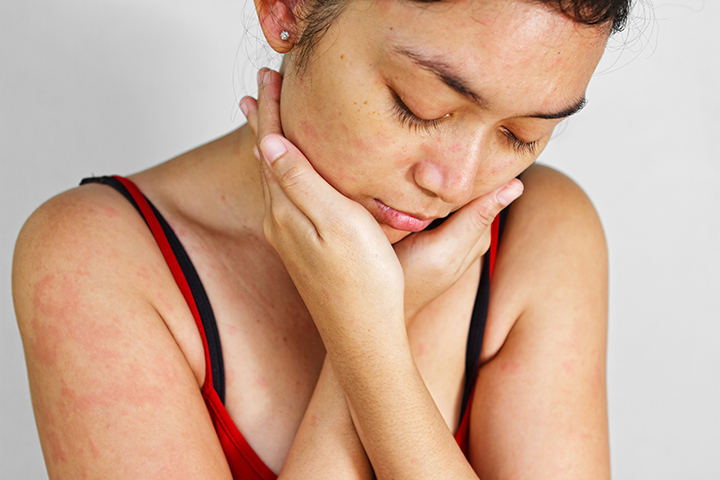
Pesky rashes are a common complaint among those who come to see us at our allergy office. However, patients often arrive with misconceptions about the rash that’s got them irritated. Today, I will delve into the most common triggers for this itchy condition.
What are hives?
Hives are a result of histamine, which is released by naturally occurring cells in the body, called mast cells. Mast cells can be found in our skin and other organs, and typically cause itchy, splotchy, rashes with raised centers that can resemble mosquito bites. Because histamine is short lived, hives normally only last a few hours.
Common causes
Among the common causes of hives described below, environmental allergies did not make the list. Why? While often at the forefront of people’s minds, environmental allergies are an uncommon cause, especially when other symptoms — such as itchy eyes and a runny or stuffy nose — are not present. Two possible causes of environmentally triggered hives: playing in grass, which can cause small red spots; or being licked by animals for those who are allergic to a protein found in pet saliva.
Food allergy
Hives are the most common symptom of a food allergy. The pattern is fairly easy to recognize. Food triggers will provoke hives quickly; sometimes they come within minutes of eating the offending food and are generally not delayed by more than two to four hours. Peanuts, tree nuts, shellfish, eggs and milk are the most commonly allergenic foods.
Medicine allergy
The most common medicines to trigger hives are antibiotics and pain relievers, such as ibuprofen, Motrin, Aleve and aspirin, but not Tylenol. It’s possible that people who have taken these medications for years can suddenly have rashy symptoms. In these cases, the medicine hasn’t changed, but the patient’s immune reaction has.
Viral infections
Viral infection is the most common cause of hives that can last days to weeks. The body gets excited about fighting the infection and begins provoking mast cells to release histamine. Sometimes the hives start while the infection is active, other times they begin shortly after the infection.
Autoimmune hives
Autoimmune hives are thought to be a progression from hives caused by viral infections or from an underlying internal immune process. In the case of a viral infection, the body continues to fight long after the virus is cleared, while the mast cells continue to release histamine. The problem may be due to a protein receptor on the mast cell that looks similar to a protein found on the infecting virus. Immune system confusion ensues. Symptoms can last weeks to months and even, in a few cases, years. Long lasting cases of hives are most commonly autoimmune in nature, and may be related to an internal autoimmune process.
Physical hives
Some hives are triggered by physical conditions affecting the skin. The most common is skinwriting, also called dermatographism, where scratching leaves long welts across the skin. Other physical hives include:
- Pressure – Caused by tight clothing or sitting for example
- Vibration – Caused by an object or activity, such as construction machinery or recreation, like mountain biking
- Cold – Caused by exposure to cold temperatures, such as swimming in cold water
- Solar – Caused by exposure to ultraviolet radiation or visible light; not to be confused with other rashes that occur due to sun exposure
- Cholinergic – Caused by a rise in body temperature, when a person is exercising, bathing, exposed to a warm environment or is under stress
How to know what causes your hives
Through a line of questioning about your hives, your doctor may be able to ascertain whether they are merely a symptom of something else. Sometimes lab work can be done to help determine the cause. Talk to your allergist if you have been unsuccessful in dealing with hives.
Good therapies exist to help relieve this bothersome and debilitating condition.
 (541) 233-4064
(541) 233-4064 
